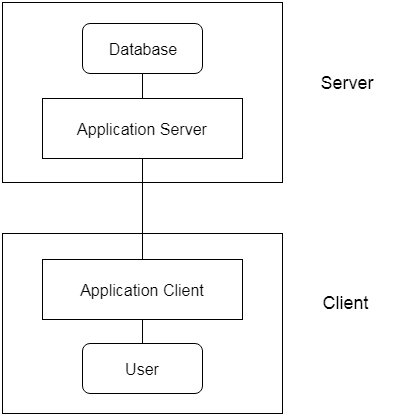
The architecture of the DBMS affects how it is designed. When dealing with a sizable number of PCs, web servers, database servers, and other components connected by networks, the fundamental client/server architecture is used.
A workstation and numerous PCs connected by a network make up the client/server architecture.
How users connect to the database to complete their requests affects the DBMS architecture.
Types of DBMS Architecture:
A single tier or multiple tiers can be seen in database architecture. But logically, there are only two types of database architecture: two-tier and three-tier.
2-Tier Architecture:
A basic client-server architecture is a two-tier architecture. Applications on the client end can speak directly with the database on the server end when using a two-tier architecture. APIs like ODBC and JDBC are used for this interaction.
Client-side computing is used to run the application programs and user interfaces.
The server side provides functionalities like query processing and transaction management.
The client-side application creates a connection with the server side in order to communicate with the DBMS.

3-Tier Architecture:
The 3-tier DBMS architecture is a software design pattern that separates the database management system into three layers, each with its unique responsibilities. The three tiers are:
- Presentation Layer: The presentation layer is responsible for displaying data to the user and receiving input from the user. This layer is responsible for the graphical user interface (GUI) and interaction with the end user.
- Application Layer: The application layer is responsible for processing the data and performing business logic. This layer is responsible for communicating with the presentation layer to receive user input and provide results, and with the database, layer to access the database.
- Database Layer: The database layer is responsible for managing the database and ensuring data consistency. This layer is accountable for creating, storing, and retrieving data from the database. The database layer communicates with the application layer to provide access to the data stored in the database.

The 3-tier architecture provides a clear separation of responsibilities, which makes it easier to manage the database and ensure that the system remains scalable and maintainable. Additionally, this architecture provides a higher level of security, as the database is kept separate from the user interface and application logic.
Note: also read about the Components of DBMS
Follow Me
Please follow me to read my latest post on programming and technology if you like my post.
https://www.instagram.com/coderz.py/
https://www.facebook.com/coderz.py
Staying up to the mark is what defines me. Hi all! I’m Rabecca Fatima a keen learner, great enthusiast, ready to take new challenges as stepping stones towards flying colors.
Leave a Comment
You must be logged in to post a comment.